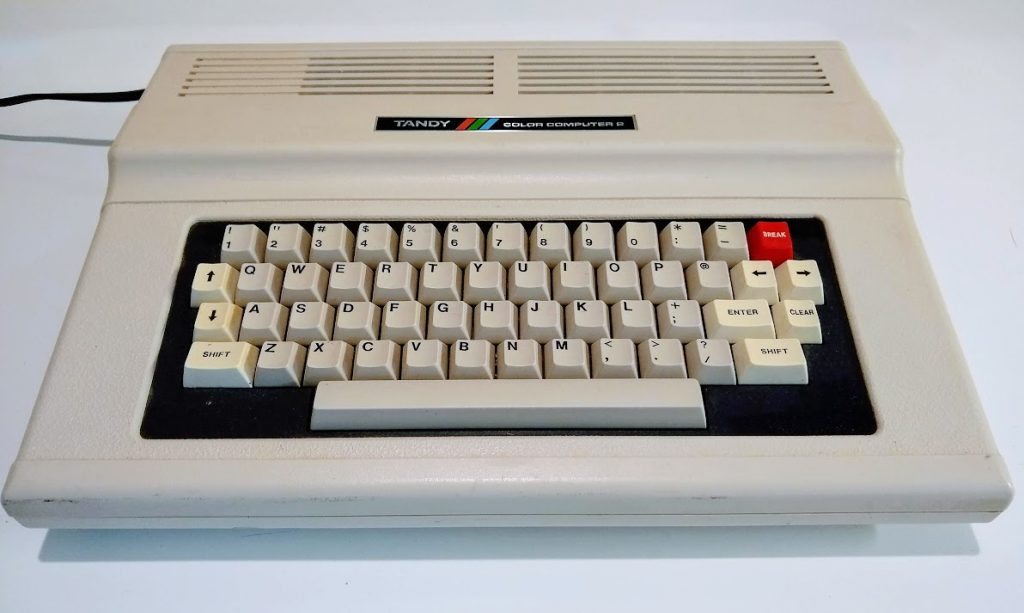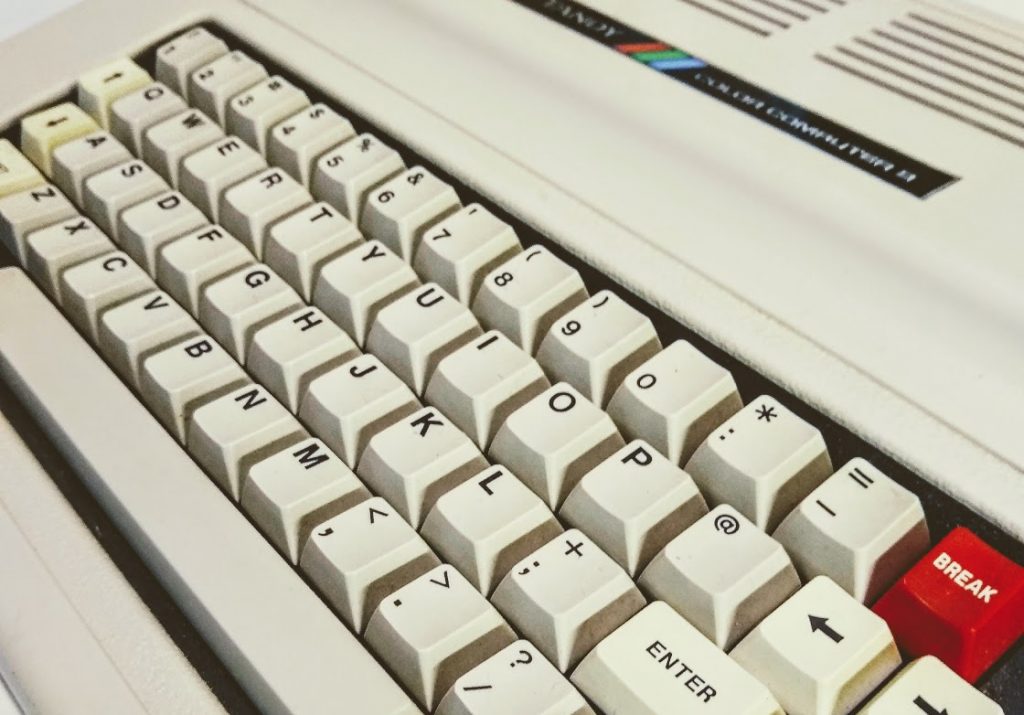Thanks to all of you for indulging me yesterday as I tried to decide whether or not I should keep my beloved TRS-80 Tandy Color Computer 2 (CoCo 2).
I conducted a survey asking this very question. As of this morning, 158 readers responded to the survey, 81.4% replied (rather, shouted) “Keep it!”:
It’s not just the survey that swayed me. Many of you pointed to the active community of CoCo 2 enthusiasts on the web that keep these simple machines alive and well and even continue innovating with add-on boards/features. I know now that when the time is right, I should fire the old girl up and run a few simple programs–perhaps even code one of those Family Computing programs. (Incidentally, if anyone has a suggestion of how to connect the CoCo2 to a modern TV with HDMI or composite/component inputs, please comment!)
Many of you also told me that I would likely have regrets in the future if I sold the CoCo 2.
I suspect you’re all right about that.
And then Robert Gulley commented:
“As someone who is downsizing radios myself, I still have my limits. Keep the computer, mainly because it is a connection, no, a very important connection, to your past. As I have grown older I have come to realize the significance of being connected to the things which touch your soul, and therefore I keep watch over those things.”
Robert knows me pretty well, so I took these words to heart.
I only have wonderful memories with the CoCo 2 and hanging with my best friend, Junior, as we tried to hack and tinker with programs.
I’ve decided that I’m going to hang the CoCo 2 on the wall in my shack and, eventually, turn it into some sort of functional art. I want to be able to pluck it from the wall and connect it to a monitor from time to time. I might even take some of your suggestions and employ it in a simple ham radio application…just because.
Thanks again for helping me with this decision!




I don’t know if anyone still considers this post, but I also used a Color Computer 2 as my first computer in the 80’s, so I know how it feels to part with it. So my vote would be for you to hold on to it, I followed a group for a while just before the pandemic, these guys brought quite a lot of nostalgia out, also a lot of hope. They showcased independent builders that made interfaces to merge existing ones still working with modern peripherals, for instance a cartridge slot to SD card adapter, lets you save and load to an SD with the same commands as floppy disks. Another makes a board that plugs into the MC6821 socket, gives a VGA plug. $99.00 but one has to determine if it’s worth it to them.
My neighbor went a lot further, he wrote a game just like Tron, but gave it a different name to avoid a copyright conflict. A few other games all in BASIC and a look-alike work-alike to Paintbrush. When I last saw his work he was writing in assembly, his uncle bought him that great big book by Lance Leventhal on 6809 assembly. I also had a book from England on 6809 routines and similar, I lent this to him a number a number of times until I just gave him, I said it was of more use to a true programmer as he was.
When we got older and left school the comradery was lost, he won a scholarship and went to England, my cousin who also had a Color 2 went his way, I got a Color 3 but without the group it was not the same, so it was not used as much. These after all were the days before IM, or even the internet. We did not have a wealth of kit with these, each of us had a cassette recorder of some sort, then I got a single sided floppy drive with an FD501 interface, my neighbor had a 3rd party double-sided pair of 40 track drives and an interface to suit. Think it was a 3 letter brand starting with J. He also had a pair of Radio Shack Joysticks later referred to as ‘black beauty’s’. My cousin had a pair of the deluxe type with 1 red button each; as I got these after them I got a deluxe with the extra button we couldn’t use. It needed the C 3 to take advantage of the button 2. All three of us had 64k RAM, theirs I believe were bought as 32k then upgraded, then I came along and the 64k model was available. I remember him commenting that my keys had a different feel.
All said its 2025 and I have my CoCo2, 3, the disk drive, an FD501 that doesn’t work. A Tandy DMP 107 dot matrix printer and that joystick. I somehow lost a Dungeons of Daggorath cartridge. I still like 80’s joysticks. I added a digital model to my collection in recent years, a Contriver Corporation Winner 770; I intend to convert to a Winner 909 analog.
I could go on about these days; I also have a working Apple IIc, and non working TRS80 Model III and Amstrad PCs. Could probably find 2 Commodore 64s searching around. I have also written simple BASIC code for Commodores, BBC Micro A’s and NCR Decision Mate V’s. All of these use mechanical keyboards of course.
The CoCo 2 cassette port is capable of sending and receiving CW. Two contacts of the cassette port connect directly to the switch contacts of a relay inside the CoCo. At lower speeds the could “key” a radio, however connecting circuits to the audio in and out of the cassette port might work better, In fact, the cassette port alternates between two tones when sending or receiving data to / from the cassette. These two tones are generated by a DAC, there for ANY TONE could be sent. It can also set to output to any or 64 level and maintain that, note we are talking audio levels so a guess 0 to a volt or two in 63 steps. The input from the cassette can be redirected to the TV/Monitor you use.
The serial port does NOT use hardware to send serial data, it is software. It can actually send or receive ANY serial data within limits. It can send about 115k. Need to send / receive 5/6/7/8/9 bit serial data? The CoCo can be used as a teletype machine, heck I don’t know enough, but possibly it can even be a TNC??? Don’t know enough about TNCs to know, but it could send and receive data at 9600 baud.
You can use it as a terminal for your “PC”, or as a terminal for an existing TNC. Be creative!!!
Now I’m *really* glad I didn’t sell it! 🙂
I had no idea–thanks!
Thomas
TNCs came to ham radio at a time when home computers were limited. It in effect emulated arpanet’s node controllers. A whole computer just for this function? But it means the software is only written once, and it has the one unique bit of hardware, the USART (a UART for synchronized comunication).
Oddly enough, the first or one of the first TNCs used the 6809, but soon the shift was to the Z80, or was it 8080?.
I’ve never seen a TNC that did the USART in software. There was software to do packet on the Mac, just adding a modem, but the Mac had two USARTs for serial interface.
When I ran Microware OS-9 on my Color Computer, multitasking, I’d start printing something, and it slowed things down so much that I’d see the cursor move around the screen when editing something. Way too sluggish to be useful. The serial timing had to be precise, so the software UART got priority.
I was at the Montreal Amateur Radio Club meeting in May of 1978 when amateur packet radio was first displayed.
Please allow me to humbly suggest, for your listening pleasure, The CoCo Crew Podcast:
http://cococrew.org/
Enjoy!
Listen to us Thomas, we’d never steer you in the wrong direction, hi hi.
Ha ha! That’s great to know, OM! You’ve got my back!
Cheers,
Thomas
It’s been so long, I can’t remember how I hooked my CoCo to the open frame surplus monitor I had. The III did have direct video output. I re.ember bringing the CoCo II home, trying it with the tv set, then opening it up to get the video signal. But I can’t remember details. It was a fairly common mod, so you can easily use it with a composite? video input.
But the RF modulator is inside the CoCo II. So shielded cable with suitable connectors will get you going, assuming the set does ana!og tv. There was a little box at the end of the cable that came with the CoCo, but it was just a switch to choose between the tv antenna or the CoCo.
Michael
Welllll
https://retrocomputing.stackexchange.com/questions/6700/how-to-connect-a-tandy-color-computer-to-a-composite-monitor
🙂
Or either, with a handful of components and some soldering, one may build this adapter
http://www.bhabbott.net.nz/coco_s-video.html
which allows to have an S-Video output from the CoCo
But you HAVE to own the period correct equipment to play ‘pong’ on. Doing it on an Intel 8 gen. just isn’t right.
And on an Intel 8 gen makes Pong “ping” too fast, right?!?! 🙂 Ha ha!
I knew you would keep it and Ill tell you why… You were not ready to let go of that part of your life… Its sort of like a divorce: You just know when its time to give up… until then you hang on and try to do the right thing. However, if one constantly looks back he wont necessarily be ready for the future. Lot’s wife looked back and you see what that got her. When one gets to that age where the past turns into those “good ol’ days,” then perhaps its time to rethink less mature connections – perhaps a little like thumb sucking, streaking, binge drinking, unprotected sex, and CoCos… My dad lived in a house full of those GOOD OL’ DAYS and died a miserable old man. He retreated backwards into obscurity and left not a single jot or tittle of personal history of which his progeny might read and learn. Oh well… it takes all kinds. Did you realize that we don’t even know her name? Why is that??
Hoooorayyy 😀 !!
Oh, and… Thomas, please DON’T “hang it to the wall”, it isn’t the head of a buffalo/deer/lion/unicorn, it’s a computer, and if, as I suspect, it’s still working, hanging it to the wall like some “dead critter” isn’t exactly a nice thing to do.
Not just that, if I’m not wrong, the CoCo has audio input, this means that, with a bit of circuitry, you may turn it into… an SDR !! Now imagine writing a post/article titled “An SDR from the 80s” 😀 !!!